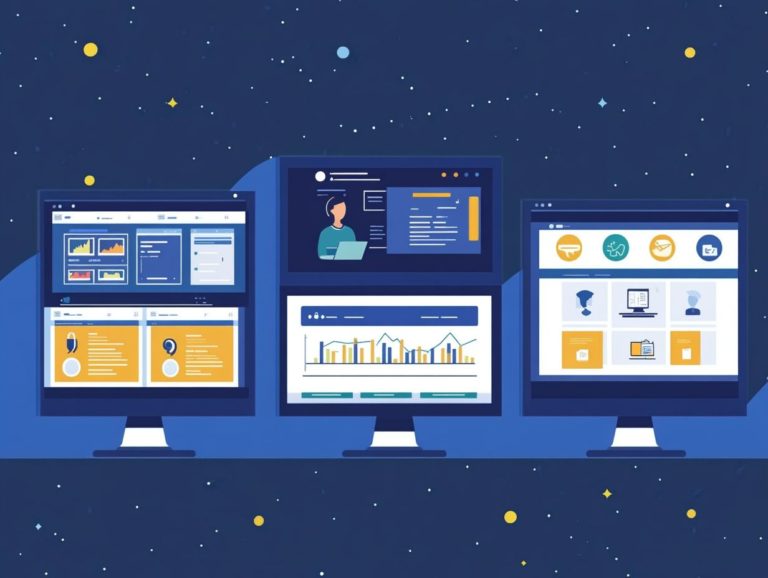How to Conduct a SaaS Risk Assessment
In today s digital landscape, Software as a Service (SaaS) is essential for businesses of all sizes. The convenience of cloud-based solutions creates an urgent need for effective risk assessment.
This guide delves into the significance of SaaS risk assessment and provides a comprehensive, step-by-step process for identifying, evaluating, and managing potential risks.
By grasping these concepts, you will be well-prepared to protect your organization s data and uphold operational integrity.
Contents
Key Takeaways:

SaaS risk assessment is a vital process for identifying and managing potential risks in a SaaS environment. Conducting a risk assessment involves steps such as identifying risks, evaluating their likelihood and impact, and implementing management strategies.
Regular monitoring and updating of the risk assessment is necessary to ensure continued protection against potential risks.
Understanding SaaS Risk Assessment
Grasping the nuances of SaaS Risk Assessment is essential for organizations harnessing SaaS applications. This process is your ticket to unbeatable data security and adherence to numerous regulations, including GDPR, HIPAA, and PCI.
A thorough risk assessment allows you to pinpoint potential vulnerabilities and threats that could jeopardize operational risk and data protection. This effectively safeguards sensitive information.
As SaaS vendors proliferate, cultivating a strong security posture is vital for upholding trust and compliance.
What is SaaS Risk Assessment?
SaaS Risk Assessment involves evaluating the security controls and protocols surrounding Software as a Service (SaaS) applications. This ensures alignment with established standards and best practices for data management and vendor security.
It s important to conduct a meticulous examination of elements such as data encryption, access controls, and incident response plans to effectively protect sensitive information. Focusing on vendor security is crucial, as the reliability of a third-party provider can significantly influence your overall risk profile.
Aligning your assessments with prominent frameworks and standards like ISO 27001 or SOC 2 is vital. These frameworks offer structured methodologies for evaluating the security posture of SaaS platforms.
By adhering to these standards, you ll be better equipped to manage vulnerabilities, meet compliance requirements, and build trust with your customers.
Why is it Important?

The significance of SaaS Risk Assessment cannot be underestimated; it is your key to mitigating compliance and operational risks associated with SaaS vendors. This proactive approach safeguards against data loss and addresses potential security vulnerabilities.
Don’t risk it! Neglecting this crucial assessment can lead to serious consequences, as seen in high-profile breaches like the Dropbox incident, where millions of user accounts were compromised due to insufficient vendor oversight.
Failing to conduct thorough risk evaluations can lead to non-compliance with regulations such as GDPR, exposing you to hefty fines and reputational damage.
Prioritizing effective SaaS risk assessments not only enhances your security measures but also streamlines the vendor vetting process, enabling you to establish a robust security posture. By pinpointing potential threats early on, you position yourself to respond more effectively to the ever-evolving landscape of cyber threats.
The Process of Conducting a SaaS Risk Assessment
Conducting a SaaS Risk Assessment requires a meticulous approach that encompasses security assessment methodologies, in-depth risk analysis, and detailed documentation.
This structured process ensures a comprehensive audit that effectively identifies potential threats and vulnerabilities within SaaS applications, safeguarding your organization s interests and enhancing overall security posture.
Start assessing your SaaS risks today to protect your business!
Step-by-Step Guide
Conducting a SaaS Risk Assessment starts with identifying security measures and implementing encryption. Establish effective monitoring options to manage potential incidents.
This approach helps you evaluate your current security and find vulnerabilities that could expose sensitive data.
The first step is to identify and categorize your data. This will help you understand the specific risks associated with it.
Tools like risk matrices can visualize the likelihood and impact of potential security breaches.
As you proceed, develop procedures for addressing incidents. This ensures a prompt response to any emerging threats.
Continuous monitoring, including automated solutions and regular audits, is vital for detecting anomalies.
By using strong encryption, you boost data protection. This ensures your information stays safe from malicious actors.
Identifying Potential Risks

Identifying potential risks is crucial for your SaaS Risk Assessment. It uncovers security vulnerabilities in third-party applications and evaluates data security to protect sensitive information.
Common Risks in SaaS
SaaS poses several common risks, including data loss, compliance issues, security breaches, and privacy concerns. These risks can lead to significant disruptions and legal trouble.
Data loss may happen due to technical failures or inadequate backup systems, causing service interruptions and revenue loss.
Failing to comply with regulations like GDPR can result in hefty fines and reputational damage.
Weak authentication methods often lead to security breaches, exposing sensitive information and risking identity theft.
Privacy concerns can lower user satisfaction and complicate compliance with regulations.
Evaluating and Prioritizing Risks
To evaluate risks, assess their likelihood and potential impact. This helps you implement effective risk mitigation strategies.
Assessing Likelihood and Impact

Assessing likelihood and impact is key to risk analysis. It helps quantify potential threats and implement necessary security controls.
Use both qualitative methods, like expert assessments, and quantitative techniques, such as statistical models, to evaluate risks.
Combining these approaches creates comprehensive profiles that enhance your risk management strategies.
Mitigating and Managing Risks
To manage risks effectively, implement proactive strategies. This includes adopting strong security measures and developing backup plans.
These steps ensure data integrity and accessibility, protecting your valuable information from unforeseen challenges.
Implementing Risk Management Strategies
Implementing risk management strategies requires establishing a comprehensive security framework. This framework must address workplace risks, ensure compliance with regulations, and employ strong data protection measures.
To effectively implement such a framework, start by conducting detailed risk assessments to identify vulnerabilities in your systems and processes. Prioritizing these risks based on their potential impact allows for a targeted approach to mitigation.
Integrating workplace risk considerations means committing to ongoing monitoring and regularly reviewing your existing protocols to adapt to emerging threats. Incorporating advanced data protection technologies is crucial, as they play a vital role in safeguarding sensitive information, ensuring confidentiality even in the event of a breach.
Train your employees on best practices and security awareness to strengthen your overall defense.
Monitoring and Updating the Risk Assessment
Monitoring your risk assessment is crucial! It s an ongoing journey that requires your attention.
Emphasize continuous monitoring, maintain thorough security documentation, and conduct regular risk evaluations.
This proactive approach allows you to adapt seamlessly to evolving threats and compliance requirements, ensuring that your security measures remain robust and effective.
Regular Check-ins and Adjustments
Regular check-ins and adjustments to your risk assessment process are essential for keeping evaluations relevant. Ensure that your security controls align seamlessly with vendor vetting procedures and compliance risks.
Ongoing evaluations are vital for identifying emerging threats and vulnerabilities that could impact your organization. By consistently reviewing your security measures and integrating new insights, adapting controls to the ever-evolving landscape of potential risks becomes easier.
Maintaining effective data management practices within this framework supports accurate assessments and enhances your overall security posture. This keeps all stakeholders informed and prepared.
This proactive approach fosters a culture of awareness, driving continuous improvement in your risk management strategies and bolstering organizational resilience.
Frequently Asked Questions
Got questions about SaaS risk assessments? We ve got answers!
What is a SaaS risk assessment?
A SaaS risk assessment is the process of identifying, analyzing, and evaluating potential risks associated with using a Software as a Service solution. It helps businesses understand potential vulnerabilities in their SaaS environment and develop strategies to mitigate them.
Why is conducting a SaaS risk assessment important?
Conducting a SaaS risk assessment is essential for several reasons:
- It helps identify potential risks and vulnerabilities in the SaaS environment.
- It assesses the possible impact of these risks.
- It aids in developing strategies to mitigate risks.
This can prevent costly data breaches, downtime, and reputational damage.
What are the steps involved in conducting a SaaS risk assessment?
The steps typically include:
- Identifying the scope and objectives.
- Gathering information about the SaaS solution.
- Evaluating potential risks and their impact.
- Identifying and prioritizing controls.
- Creating a risk management plan.
Who should be involved in conducting a SaaS risk assessment?
Conducting a SaaS risk assessment involves collaboration between various stakeholders, including:
- IT teams
- Security experts
- Business managers
- Other relevant personnel
These stakeholders provide valuable insights and expertise in identifying and mitigating potential risks.
What are the key considerations for a SaaS risk assessment?
Key considerations include:
- Data security
- Compliance with regulations and standards
- Reliability and availability of the SaaS solution
- The potential impact of risks on business operations
- The reputation of the SaaS provider
- Data backup and recovery processes
- Disaster recovery plans
How often should a SaaS risk assessment be conducted?
The frequency may vary based on industry and sensitivity of data. However, a risk assessment must be conducted at least once a year or whenever significant changes occur in the SaaS environment or new security threats emerge.




